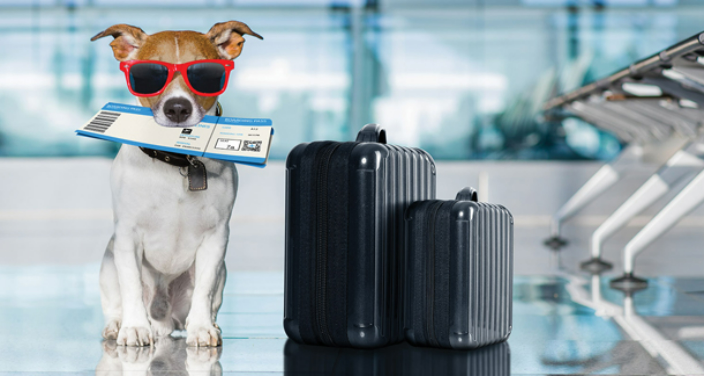Smooth Travels: A Quick Guide to Pet Transportation. Our dogs and cats are cherished members of the family. With that in mind, when it comes to transporting pets, you should study up on how it works, and how to get it right. Here are some helpful Q&A’s to get your journey started…
What is the procedure for long-distance pet transportation?
When it comes to transporting your pet over significant distances, several options are available. Many airlines permit small pet parents to bring their furry companions into the cabin, provided the carrier fits underneath the airplane seat. Alternatively, your pet can travel in the plane’s cargo hold, but rest assured, it won’t be mingling with the luggage. Carriers are stored in a separate, secure section for the pet’s safety and comfort. Using top-quality cat carriers, dog crates, or rat cages is essential to ensure a safe journey. Pet transportation companies can also employ these methods while handling all logistical concerns on behalf of pet owners.
What is the recommended approach for pet transportation?
The most ideal method for pet transportation is having your pet accompany you on the journey. If that’s not possible, the next best option is to enlist the services of a specialized pet moving company. While this can be costly, these services are experts in ensuring the safe and low-stress relocation of your pet to its destination.
Are pet transport companies reliable and safe?
Reputable pet transport companies are indeed safe to utilize. However, it’s vital to thoroughly vet any pet transportation service before making a selection. A reliable pet transport service should possess USDA certification and be a member of the International Pet and Animal Transportation Association (IPATA). Moreover, they should be able to provide you with a clear and comprehensive explanation of their transportation procedures.
What is the most cost-effective way to transport a dog?
If your dog, along with its carrier, weighs less than 20 pounds, one of the most cost-effective options is to take your pet with you on a plane. Most airlines charge a flat fee, typically around $75, for pets to travel in the cabin or between $100 and $250 to transport them in the cargo hold. Alternatively, you can opt for a pet transportation service, which can transport your pet in a van with other animals or, for a higher cost, with dedicated handlers.
Quote: “The most important aspect of safe pet transportation is trust. Trust that every handler, every mile, and every moment is centered around the pet’s comfort, security, and well-being.” – Kevin Kinyon, Founder of Petworks
How can a large dog be transported across the country?
The most reliable method for transporting a large dog across the country is by air. Numerous airlines allow for dogs to travel in a crate located in the cargo hold of the plane. This method is safe because the cargo hold is pressurized and temperature-controlled, and the crates are securely fastened to ensure your pet’s well-being.

Did you find this article useful? Would you like 100% free access to more articles like these, and free access to over 5,000 vetted pet care service professionals throughout the United States? Sign up here for a free Petworks account, and take 10% off your first booking, on us!
What are the options for transporting a puppy from a breeder?
There are several options for transporting a puppy from a breeder to its new owner. The breeder can arrange a commercial airline flight for the puppy or even have a registered handler accompany the dog in the cabin to its new home. For shorter distances, ground transportation in a carrier within a van with other dogs is feasible. Breeders can also enlist the services of a USDA-certified pet transportation service to ensure the safe transport of the puppy to its new owner. It’s important to note that most airlines and pet transport services require puppies to be at least 8 weeks old before travel.
So how much does pet transportation actually cost?
For domestic pet air travel within the USA, the starting rate typically begins at approximately $1,500 USD. Should you require additional services like airport pick-up/delivery or prefer ground transportation, the cost will generally depend on the mileage.
If your pet’s journey is international and you opt for a comprehensive door-to-door pet transport service, the initial cost for a single pet typically starts around $4,500 USD. It’s worth noting that transporting pets to countries with more intricate pet import requirements, such as Australia and New Zealand, can be pricier.
 Please keep in mind that these prices do not encompass any preliminary veterinary visits necessary to ensure your pet complies with import regulations. The expenses for veterinary services may vary depending on your chosen veterinary clinic and the extent of treatments needed.
Please keep in mind that these prices do not encompass any preliminary veterinary visits necessary to ensure your pet complies with import regulations. The expenses for veterinary services may vary depending on your chosen veterinary clinic and the extent of treatments needed.
If you’re considering in-cabin or accompanied baggage pet travel (provided your pet meets the criteria), airline transportation expenses usually amount to a few hundred dollars. Once again, this doesn’t cover any preliminary veterinary visits or additional services like customs clearance or quarantine required for the import process.
What Is A Flight Nanny?
For pet parents seeking a stress-free travel solution, flight nannies provide a secure and compassionate alternative to cargo shipping. These professionals accompany pets in the cabin, offering constant supervision and care. By managing all flight logistics and providing real-time communication, flight nannies ensure pets’ well-being and offer owners peace of mind, especially during long-distance moves or when personal accompaniment is impossible. Their expertise in pet care and first aid makes them a reliable choice for any pet’s air travel needs.
Prioritize your pet’s safety by hiring a top rated professional
Choosing a professional pet transport service can offer you peace of mind and ease the often stressful process of pet travel. Whether you’re planning a vacation or a permanent relocation, your mind is already filled with numerous considerations. By placing your beloved pet in the care of a well-established and experienced company, you can alleviate the stress, anxiety, and concerns that usually accompany pet travel preparations. Opting for a top-rated company helps guarantee a secure and comfortable journey for your furry companion.
About the Author
 Petworks Co-Founder Kevin Kinyon is a life-long animal lover who works tirelessly to improve the lives of pets and their parents. Human and animal qualities he values most are integrity, humor, and empathy.
Petworks Co-Founder Kevin Kinyon is a life-long animal lover who works tirelessly to improve the lives of pets and their parents. Human and animal qualities he values most are integrity, humor, and empathy.


